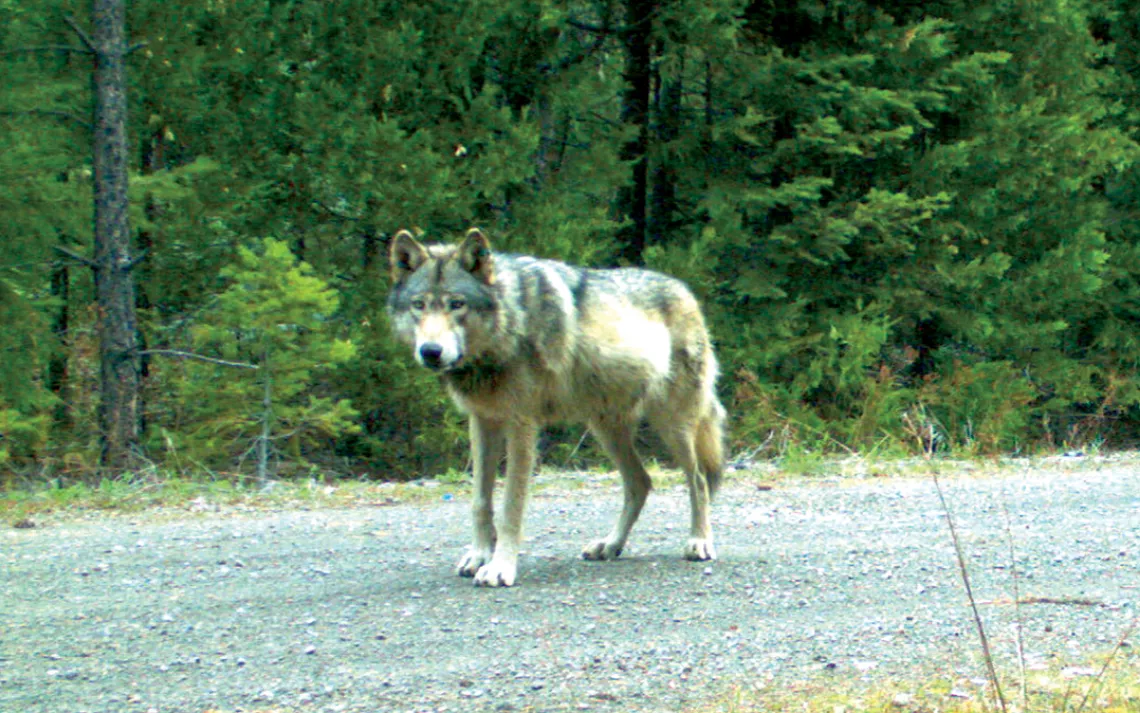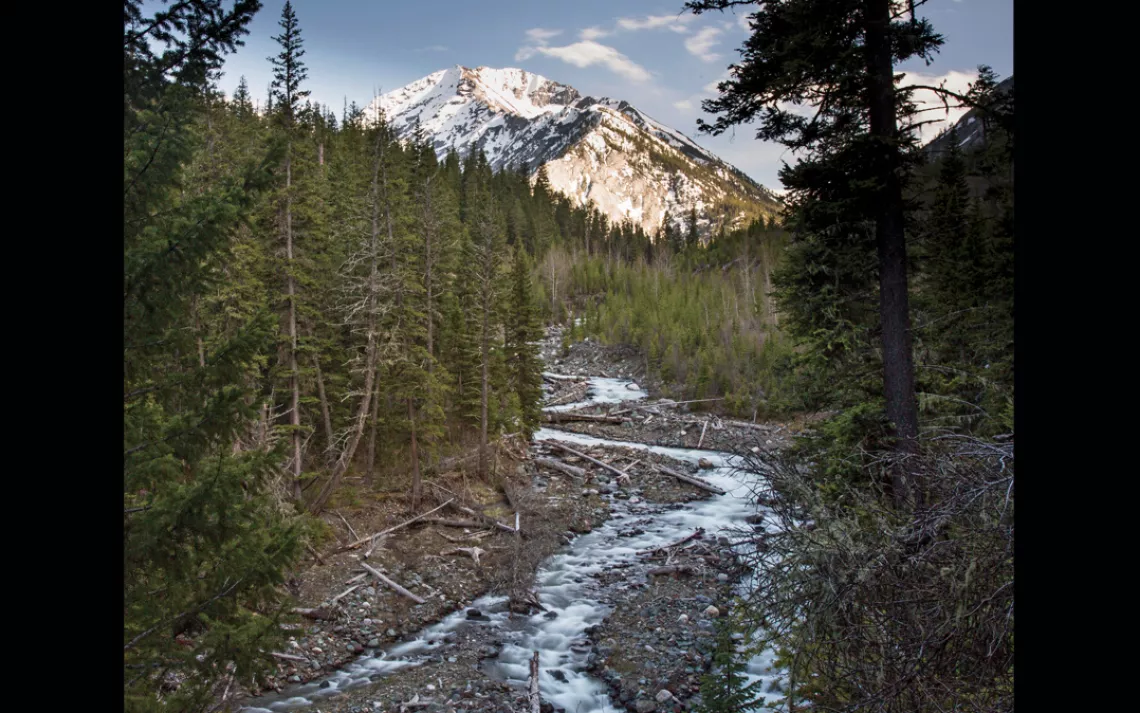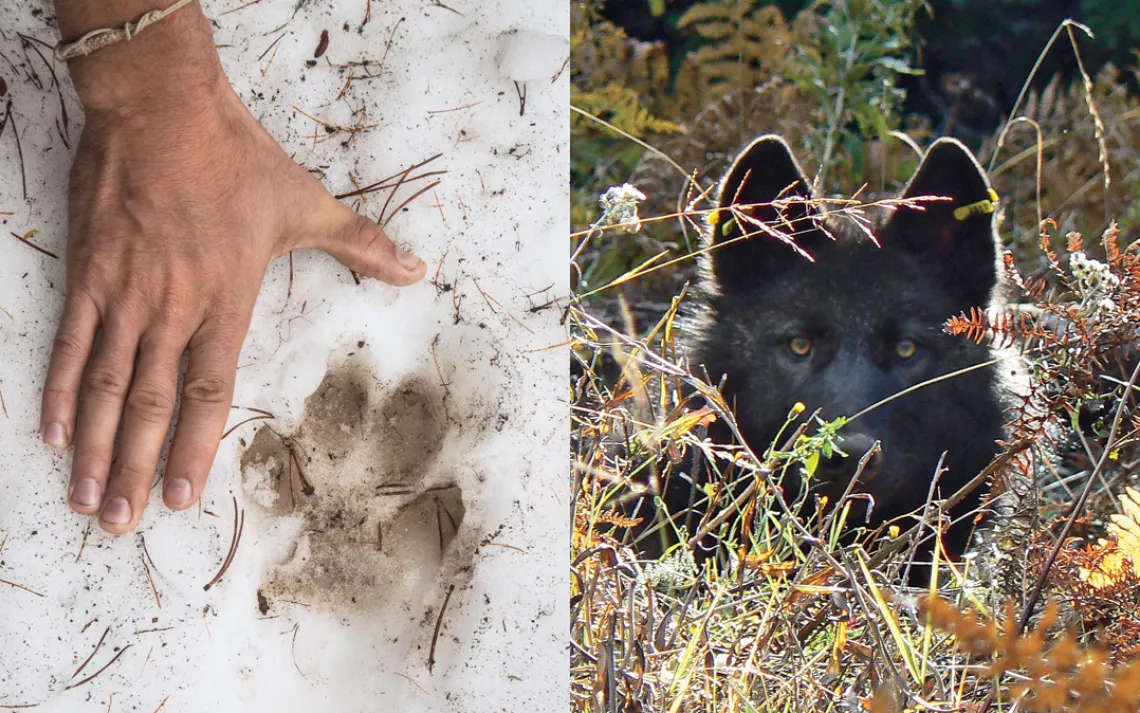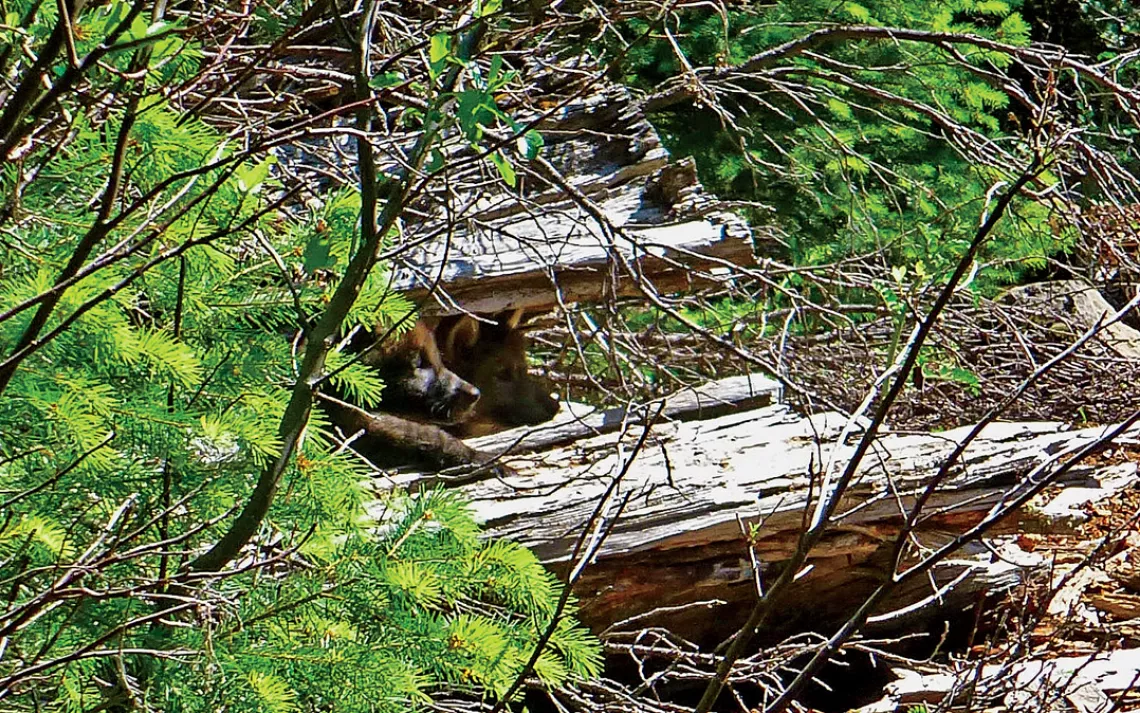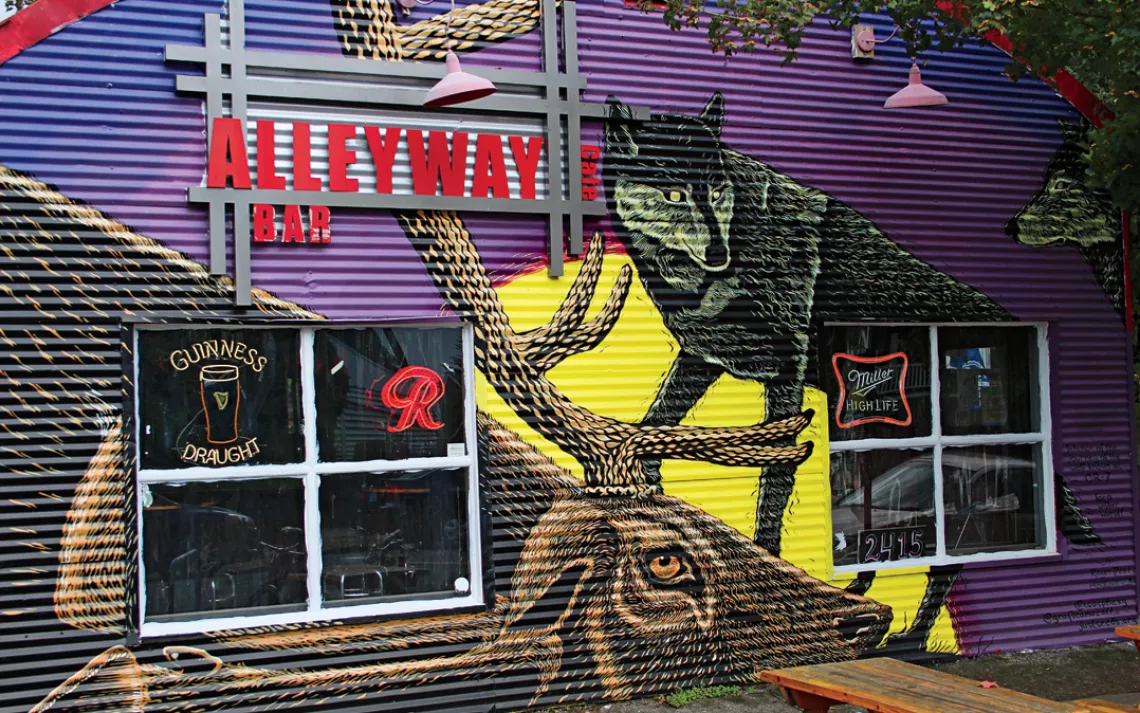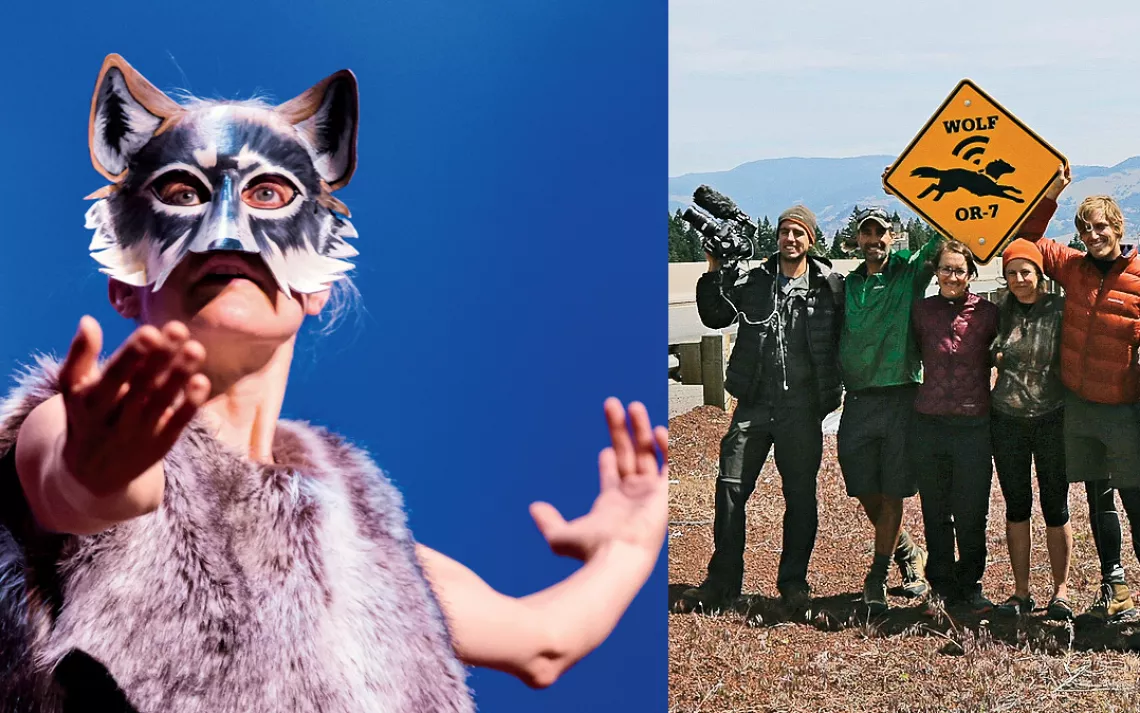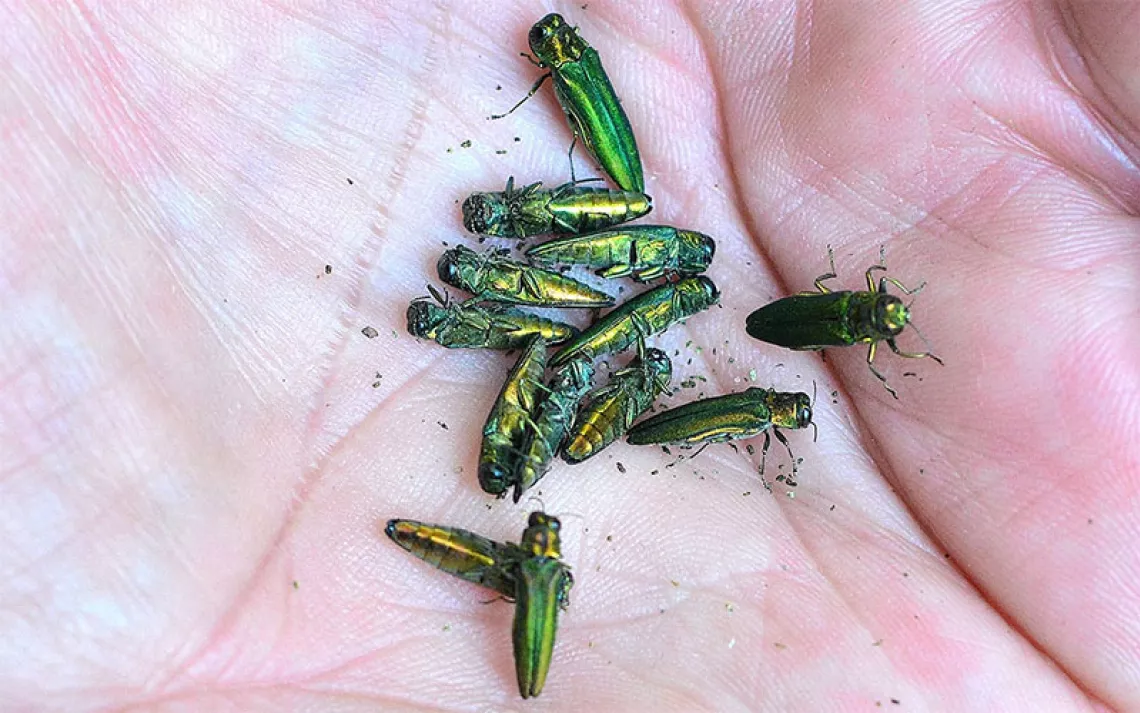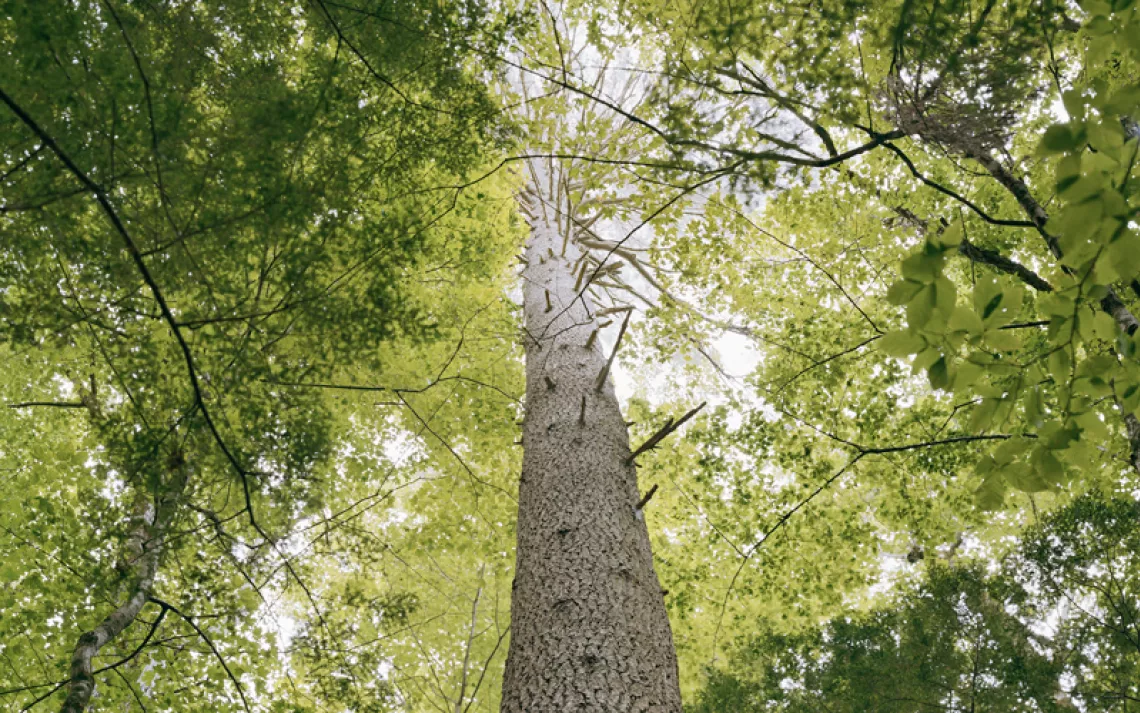Underdog
Celebrity wolf OR7 may be “too famous to kill,” but his pups will need to watch out if they wander into the wrong state
I’m heading home to Portland from a cabin in the central Oregon woods, down a road I’ve traveled a thousand times before, when something new comes loping through the forest. It’s moving fast without rushing. My brain registers graceful first. Then coyote. But no, it’s too tall and slender.
Then it hits me: Wolf!
It’s already gone.
I grew up in these woods. I like to think I know them. Black bears and mountain lions live out here, plus bobcats, beavers, and the occasional fox. At night you can hear great packs of yipping coyotes coalescing for a hunt.
But there aren’t any wolves.
Except, I remember a heartbeat later, that’s not completely true: A lone male wolf came through here a few years ago. It was a big deal—America’s most famous wild canid. And he had a funky name, like a robot: OR7.
He was Oregon’s seventh wolf to be caught and fitted with a radio collar—hence the name. He was from the Imnaha Pack, which roamed the northeastern corner of Oregon. But sometime in September 2011 he left the pack and wandered southwest, crossing four mountain ranges and five national forests, all the way down into California. He got halfway to Sacramento before circling back to southern Oregon.
Oregon’s Department of Fish and Wildlife released information on his general whereabouts, and for a while everyone went wolf-crazy. Someone started a parody Twitter account for @WolfOR7. (“Attn. Oregon backpackers. You can keep your trail mix but I wouldn’t mind some of your beef jerky.”) We were all enamored with his 3,000-mile against-all-odds search for a fresh start and a mate.
It was a remarkable PR coup for a species long regarded as a pest, or worse. Humans, after all, have been demonizing wolves ever since we started filling our pastures with delicious, defenseless livestock. In his book Where the Wild Things Were, William Stolzenberg writes that the first systematic attacks on wolves took place alongside the birth of farming in the Nile River Delta, 10,000 years ago. Agriculturalists in this country share the antipathy. In 1843, the first semblance of Oregon’s state government was voted into existence at “wolf meetings” meant to address the problem of lost livestock. Not long after, the whole country embarked on an extermination campaign in which wolves were trapped, shot, poisoned, disemboweled, and lit on fire. Once airplanes were invented, they were put to work dropping cyanide-laced pellets of fat from the sky. In Alaska, wolves are still shot from planes.
A few cagey survivors grew legendary in their refusal to be caught, though traps sometimes claimed parts of a paw: A wolf named Three Toes terrorized Harding County, South Dakota. New Mexico had Old Three Toes. Old One Toe roamed Arizona. None had Twitter accounts.
Eventually, however, the West was won. Oregon’s last wolf was killed in 1947 for a $25 bounty, and ranchers slept easily at night. Devastated by population reduction, wolves became different beasts—underdogs.
In 1995, the tide began to turn. The U.S. Fish and Wildlife Service introduced 66 wolves from Canada back into Yellowstone National Park and surrounding areas in Montana and Idaho. By 1999, wolves were starting to turn up in Oregon. Ten years later, the Imnaha Pack had taken up permanent residence just west of the Hells Canyon Wilderness on the border with Idaho. OR7, who had been tagged and radio-collared eight months earlier, dispersed in search of new territory in 2011. As he wandered, wolf supporters played up his celebrity status in a concerted effort to make him, as the Huffington Post put it, “too famous to kill.”
Now, here in central Oregon, as I scan the trees for another glimpse of the gray wolf that just crossed my path, it strikes me that this must be a new disperser, following in OR7’s path.
Three weeks later, just outside Joseph, Oregon (population 1,052), I’m halfway up Finley Butte and creeping toward the summit. It’s a little past 4 a.m., and the sunrise just cracked open the skyline behind me, staining the Wallowa Mountains a radical violet and rousing a chorus of birds.
“If we want to get wildlife shots, we need to get in close without the birds announcing our presence,” whispers Michelle Van Naerrsen of the Wolf OR7 Expedition, a monthlong, six-person trek retracing by foot and mountain bike part of the canid’s 3,000-mile odyssey. If the birds go suddenly quiet, she says, that tells the whole valley to be afraid.
This morning is day one of the expedition, the official mandate of which is to “explore the challenges of a 21st century wolf.” We’re setting off in the crisp predawn to check out OR7’s original home range. If we’re stealthy, we might catch a glimpse of the herds of elk he hunted as a pup. The group is filming a documentary, though, not to mention blogging and Facebooking the whole trip, and our cameras keep blowing our cover. As expedition videographer Daniel Byers lines up a shot of the glowing horizon, for example, Galeo Saintz takes a picture of him with his phone. I take a picture of Saintz taking that picture. We’re here to see elk, but we’re also here to be seen trying to see elk. We’re tweeting, but now we’ve scared the birds—and they’re not.
That’s OK, I’m told. The goal isn’t finding OR7 so much as following in his footsteps, and (hopefully) inspiring a new appreciation for the creature’s wild savvy.
“There are two landscapes that we’re walking through, the physical landscape and the psychological landscape,” says Rachael Pecore-Valdez, an aquatic ecologist and storyteller who is the trip’s instigator. “I’m interested in a story that is true to both.”
Problem is, wolves are often not appreciated in either landscape. European folklore reads like a class action suit against the species: Little Red Riding Hood, Three Little Pigs, et al. v. Big Bad Wolf. For some other cultures, though, wolves are allies.
“There would be certain howls,” Joe Whittle explains to the Wolf OR7 Expedition cameras later that day. “Because of those howls, hunters would find deer or elk to hunt.”
Born in the nearby town of Enterprise and a member of the Caddo Tribe of Oklahoma, Whittle is a backcountry guide, U.S. Forest Service wilderness ranger, and student of Native American cultures. We’re in a meadow up Hurricane Creek, where the Wallowas’ tallest peak, Mt. Sacajawea, towers overhead. Whittle is describing the mutually beneficial relationship that developed between wolves and the Nez Perce tribe, as described to him by tribal elder Horace Axtell. Nez Perce hunters, he says, would kill an animal and leave a gut pile. “It didn’t take long for the wolves to realize that they could get an easy, free meal just by vocalizing where the game are. They just do a little howling and here they have an easy snack.”
It’s not just indigenous humans who benefit from the presence of wolves. Apex predators have been shown to have an outsize influence on ecosystem health, Oregon State University professor Bill Ripple tells me later. He’s best known for his work in Yellowstone showing how aspen trees thrive when wolves keep elk at bay—limiting herbivore populations as well as influencing their behavior. Moose and elk move quickly and browse more gingerly in wolf territory; the divided attention allows some aspen shoots to establish themselves.
Last year Ripple also found that wolves keep grazers from hogging all the wild berries. His team analyzed scat samples of Yellowstone grizzlies and found that the presence of wolves increased the amount of available berries.
So that means that OR7 might bring real, tangible benefits to wherever he settles, right?
Not so fast, Ripple says. Large species generally need large swaths of habitat, and humans keep carving the country into smaller and smaller pieces. It’s entirely possible that through agriculture, logging, and road building, we’ve negated any benefits that wolves could bring to the landscape. These big bad wolves may come home only to find that we long ago blew down their houses.
That is, if we let them come home at all. In the current wolf-reintroduction scheme, when recovering wolf populations hit preestablished benchmarks, they lose their endangered species protection and the states can step in to manage wolves as they see fit.
In 2008, when Idaho’s wolves were first delisted, the state sold wolf-hunting tags, and it has essentially hunted the population in and out of federal protection ever since. Montana opened a wolf season in 2011 to reduce the population by 25 percent. It came up short, so the hunting season was extended. In 2012, Wyoming classified wolves as predators that could be shot on sight. In September 2014, following a lawsuit by the Sierra Club and others, a federal judge revoked the state’s management rights and returned federal protections.
That reprieve may be temporary. In 2013, citing healthy populations in the Northern Rockies and Great Lakes regions, the U.S. Fish and Wildlife Service proposed delisting wolves across the entire country, essentially handing all wolf management decisions to the individual states. Washington, Oregon, and California have comprehensive, science-based management plans in place or in the works for the day wolves are delisted. But should those wolves wander across state lines to, say, Nevada, it would be like entering enemy territory.
The next day, hiking toward the Imnaha River, a cold, steady rain turns to glops of slush and then snow. When my boots finally soak through, I send the expedition on its way and start driving around Wallowa County, knocking on ranch house doors. What’s it like, I wonder, to live in a place one notch wilder than it used to be?
There’s a grassy ridgeline out here called the Wolf Highway, which I figure is a good place to start. It runs between the Eagle Cap Wilderness, where elk spend their summers, and the Zumwalt Prairie, where they winter. Wolves follow the herds, but fenced-in cattle dot their path, like fast food on the interstate.
When I arrive at Lori Schaafsma’s door, she invites me in, puts the kettle on for tea, calls her neighbor, Ramona Phillips, and informs me that they both have much to say on the subject of wolves. She’s not kidding.
“When we first had wolves come here, I don’t think I had any prejudice at all,” Phillips says. “[But] it’s changed our life in every way.” Both women say they’re frustrated that they’re not allowed to protect their property; Schaafsma compares her situation to living in gang territory, where it feels like violence might erupt at any moment.
Between their two herds, however, the state has confirmed exactly one case of wolf depredation. Nationwide, wolves are responsible for less than 1 percent of lost livestock. That means zilch, though, to the individual ranchers losing cattle. The gulf between the actual numbers and the perceived threat makes managing wolves also a matter of managing people, for whom encountering a wolf on their property inspires less reverence than it does a feeling of acute vulnerability. “I don’t think people understand how close to our houses they are,” Phillips says. “It skews how we look at them. It has to.”
In Portland, where wolves aren’t devouring property or pets—not even the occasional little hipster dog—perspectives can skew the other way. On a rainy Sunday, Clemens Schenks’s documentary OR7—the Journey (not to be confused with the Wolf OR7 Expedition film) is premiering at a brewpub movie house. “Sold out!” a woman laments, as she turns from the ticket counter. It’s not a happy scene.
The timing of the premiere could not be better. The batteries in OR7’s radio collar are expected to die at any moment, but days earlier a trail camera captured him in close proximity to a small black female wolf—perhaps a mate.
The film is short on nuance and subtlety, but the pro-wolf audience doesn’t care. As it gathers steam, scattered applause turns to full-on cheers for definitive statements about the benefits of wolf reintroduction and anti-hunting policies.
“I think it says something about everyone’s fear of what’s happening to us,” an audience member tells me. “OR7 is a reason to celebrate at a time when we’re nervous about our future.” In other words, if a decimated species can find enough connected habitat to fill in the spaces we emptied of them, perhaps we’ve done something right.
Four years after leaving his pack, OR7 is still top dog in the wolf media world. Every few months someone pays tribute with a new song or an epic poem or an hourlong dance performance, and whoever’s behind the OR7 Twitter account is still going strong. Last June, U.S. Fish and Wildlife agents tromped into the woods and confirmed that OR7 had indeed found a mate and that the happy couple had at least three pups in a den not far from the California border. Adorable photos soon followed.
If the pups make it through the winter, OR7 and his mate will be considered a “breeding pair.” It takes four such pairs to constitute a minimum sustainable population, according to the state’s management plan. But beyond five pairs, wolves—even famous ones—begin to lose protections.
Under ideal circumstances, wolves can double their numbers every two years, but that’s assuming adequate territory, food supply, and genetic diversity. Much of that is still a question mark. It remains to be seen just how badly we’ve chopped up the landscape and whether or not packs in surrounding states can spin off enough wandering wolves to find each other, like OR7 and his mate. So while their union feels like a huge victory for Canis lupus, it’s a tenuous one. Given the history of famous wolves in our country and culture, you might better call it a toehold.
 The Magazine of The Sierra Club
The Magazine of The Sierra Club
